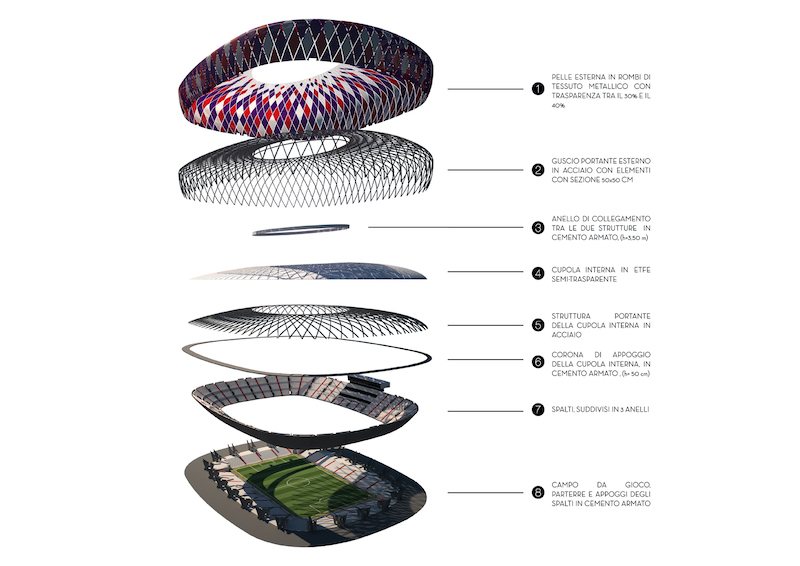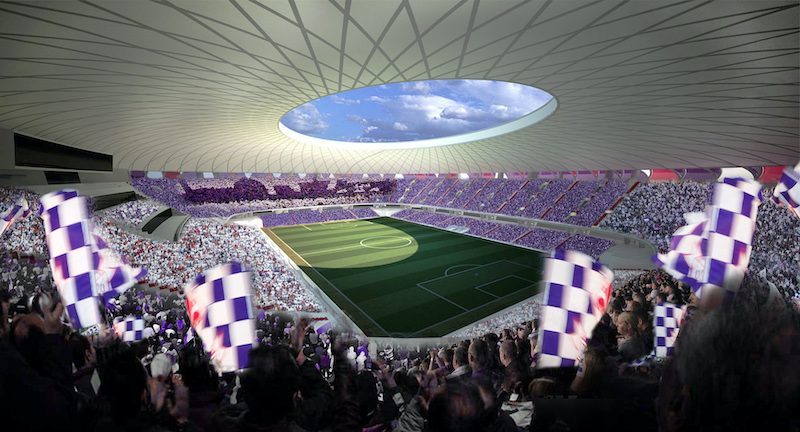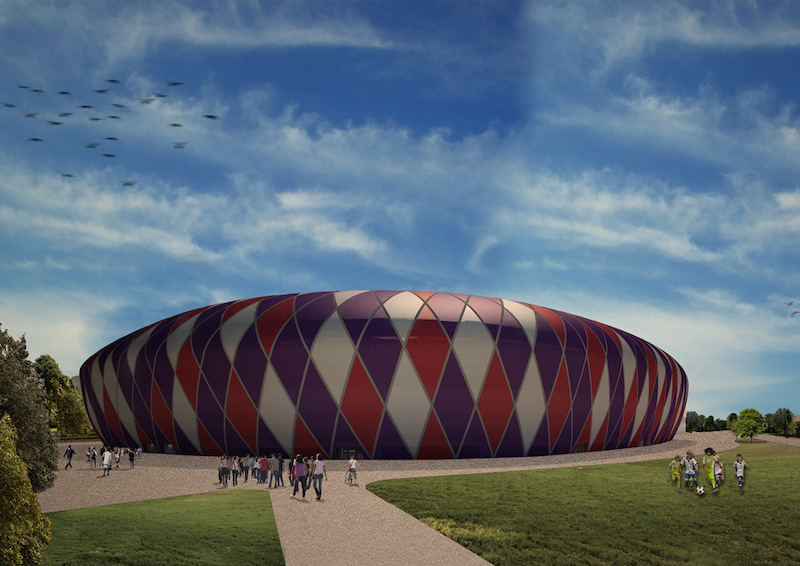Last June, Rocco Commisso, the Italian-American chairman of the cable TV provider Mediacom Communications, took ownership of the Italian soccer club A.C.F. Fiorentina, based in Florence, Italy, where the team is known locally as the Viola, for its violet-colored jerseys.
The 69-year-old Commisso, who also owns the New York Cosmos soccer club in the U.S., (and who previously tried, but failed, to acquire the A.C. Milan club in Italy) has identified the need for Fiorentina to play its home games in a modern sports stadium. Right now, the club plays at Stadio Artemio Franchi, which opened in 1931.
According to Stadium Business, the Municipality of Florence in October approved a proposal to make a plot of land available for the potential development of a new stadium.
Florence-based Pierattelli Architetture has proposed a design for that new stadium as a component of a master plan that upgrades and expands the Novoli district in the northwest part of the city. That master plan focuses on improving the area’s existing subpar road network, and creating a new road network through the city’s food and beverage market known as Mercafir.
Pierattelli envisions a rhomboid-shaped stadium that resembles a large stone, higher on one side than the other, whose outer structure is clad in metal mesh of purple, white, and red, the team’s colors. The building would have 16 entrance points (four with turnstiles), and three grandstand rings, as well as a shopping mall and food service.
The 40,000-seat stadium would have a perimeter of approximately 600 meters (1,969 feet), a maximum width of over 200 meters, and a maximum length of 150 meters. Its height would range from 30 to 40 meters, with the highest section overlooking the grandstands in front of the new entrance.
The building is designed as a series of rings. A double-volume ring at the ground floor level channels the flow of people into different areas and levels. The second ring includes VIP grandstands, and 10 skyboxes of about 172 sf each and four of which would include meeting rooms. The last ring, which dominates the stadium, would house the dividers and columns that support the building’s entire internal structure.
There would also be an underground area for a swimming pool, dressing rooms, warm-up area and wellness center, and hospitality suite through which the press room, VIP grandstands and restrooms could be accessed.

Pierattelli's stadium design revolves around a series of architectural rings.
Pierattelli has positioned its design proposal as “a new vision of the city,” that amalgamates architecture, urban planning, and social life. The 148-acre Novoli neighborhood is currently lacking modern infrastructure. Pierattelli proposes that Viale Guidone, the city’s main traffic artery, be redirected as a one-way thoroughfare underground through a tunnel whose entrance would be near the city’s railway and whose exit would be in front of the city’s Palace of Justice. Ground-level pedestrian and cycle paths would be maintained.
Another road would be added that connects the city’s Piazza Artom with its Via dell’Olmatello, and divides the Mercafir in half, making part of this road exclusively for foot traffic, and “an island of peace within an area of inter-municipal traffic,” states the architect. The Municipality of Florence has opted to put part of the Mercafir area up for sale, with a prospect of that land being purchased for the development of the new stadium, according to Stadium Business.
The master plan also proposes creating four artificial hills with a maximum height of six meters, which would establish the neighborhood’s boundaries and provide more green space for the city.
Commisso has stated his goal to move his team into a new stadium by September 2023. The question remains, though, whether the team will be receptive to the municipality’s redevelopment plan. The club reportedly is weighing leaving this area of Florence to develop its new stadium in the commune of Campi Besenzio, about 10 miles northwest of Florence.

The proposed stadium would seat 40,000 fans. An underground floor would include a swimming pool and warm-up area for the contestants. Seen from above, the stadium resembles a flower.
Related Stories
| Aug 11, 2010
Populous selected to design 'crystalline skin' stadium for 2014 Winter Olympics
Russian officials have selected global architect Populous to design the main stadium for the 2014 Winter Olympic and Paralympic Games in Sochi, Russia. The 40,000-seat stadium will feature a crystalline skin that "engages with its surroundings by day and provides an iconic representation of the color and spectacle of the games when illuminated at night," said Populous senior principal John Barrow.
| Aug 11, 2010
Best AEC Firms of 2011/12
Later this year, we will launch Best AEC Firms 2012. We’re looking for firms that create truly positive workplaces for their AEC professionals and support staff. Keep an eye on this page for entry information. +
| Aug 11, 2010
Clark Group, Mortenson among nation's busiest state/local government contractors, according to BD+C's Giants 300 report
A ranking of the Top 40 State/Local Government Contractors based on Building Design+Construction's 2009 Giants 300 survey. For more Giants 300 rankings, visit /giants
| Aug 11, 2010
Portland Cement Association offers blast resistant design guide for reinforced concrete structures
Developed for designers and engineers, "Blast Resistant Design Guide for Reinforced Concrete Structures" provides a practical treatment of the design of cast-in-place reinforced concrete structures to resist the effects of blast loads. It explains the principles of blast-resistant design, and how to determine the kind and degree of resistance a structure needs as well as how to specify the required materials and details.
| Aug 11, 2010
Gensler, HOK, HDR among the nation's leading reconstruction design firms, according to BD+C's Giants 300 report
A ranking of the Top 100 Reconstruction Design Firms based on Building Design+Construction's 2009 Giants 300 survey. For more Giants 300 rankings, visit http://www.BDCnetwork.com/Giants
| Aug 11, 2010
Gensler among eight teams named finalists in 'classroom of the future' design competition
Eight teams were recognized today as finalists of the 2009 Open Architecture Challenge: Classroom. Finalists submitted designs ranging from an outdoor classroom for children in inner-city Chicago, learning spaces for the children of salt pan workers in India, safe spaces for youth in Bogota, Colombia and a bamboo classroom in the Himalayan mountains.
| Aug 11, 2010
ASHRAE introduces building energy label prototype
Most of us know the fuel efficiency of our cars, but what about our buildings? ASHRAE is working to change that, moving one step closer today to introducing its building energy labeling program with release of a prototype label at its 2009 Annual Conference in Louisville, Ky.
| Aug 11, 2010
10 tips for mitigating influenza in buildings
Adopting simple, common-sense measures and proper maintenance protocols can help mitigate the spread of influenza in buildings. In addition, there are system upgrades that can be performed to further mitigate risks. Trane Commercial Systems offers 10 tips to consider during the cold and flu season.







